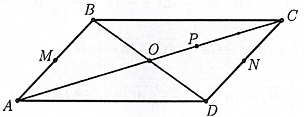Cho \(\Delta ABC\) với \(BC = a,AC = b,AB = c\). Nếu điểm I thỏa mãn hệ thức \(a\overrightarrow {IA} + b\overrightarrow {IB} + c\overrightarrow {IC} = \overrightarrow 0 \) thì:
Quảng cáo
Trả lời:
Chọn B
Lấy \(A'\) sao cho \(\frac{{A'B}}{{A'C}} = \frac{c}{b}\) hay \(AA'\) là đường phân giác.
Ta có: \(a\overrightarrow {IA} + b\overrightarrow {IB} + c\overrightarrow {IC} = \overrightarrow 0 \Leftrightarrow a\overrightarrow {IA} + \left( {b + c} \right)\overrightarrow {IA'} = \overrightarrow 0 \)
\( \Leftrightarrow \) I thuộc đoạn \(AA'\) và \(\frac{{IA}}{{IA'}} = \frac{{b + c}}{a} = \frac{c}{{\frac{{ac}}{{b + c}}}} = \frac{{BA}}{{BA'}}\)
\( \Rightarrow \) I là tâm đường tròn nội tiếp \(\Delta ABC\).
Hot: 1000+ Đề thi cuối kì 1 file word cấu trúc mới 2025 Toán, Văn, Anh... lớp 1-12 (chỉ từ 60k). Tải ngay
- Trọng tâm Lí, Hóa, Sinh 10 cho cả 3 bộ KNTT, CTST và CD VietJack - Sách 2025 ( 40.000₫ )
- Sách - Sổ tay kiến thức trọng tâm Vật lí 10 VietJack - Sách 2025 theo chương trình mới cho 2k9 ( 31.000₫ )
- Sách lớp 10 - Combo Trọng tâm Toán, Văn, Anh và Lí, Hóa, Sinh cho cả 3 bộ KNTT, CD, CTST VietJack ( 75.000₫ )
- Sách lớp 11 - Trọng tâm Toán, Lý, Hóa, Sử, Địa lớp 11 3 bộ sách KNTT, CTST, CD VietJack ( 52.000₫ )
CÂU HỎI HOT CÙNG CHỦ ĐỀ
Lời giải

Ta phân tích \(\overrightarrow {AE} \) và \(\overrightarrow {AF} \) theo 2 vectơ \(\overrightarrow {AB} \) và \(\overrightarrow {AD} \).
\(\overrightarrow {AE} = \overrightarrow {AB} + \overrightarrow {BE} = \overrightarrow {AB} + \frac{1}{3}\overrightarrow {BC} = \overrightarrow {AB} + \frac{1}{3}\overrightarrow {AD} \)
\(\overrightarrow {AF} = \overrightarrow {AB} + \overrightarrow {BF} = \overrightarrow {AB} + \frac{1}{4}(\overrightarrow {AD} - \overrightarrow {AB} ) = \frac{3}{4}\overrightarrow {AB} + \frac{1}{4}\overrightarrow {AD} \).
Xét hệ: \(\left\{ {\begin{array}{*{20}{l}}{\overrightarrow {AE} = \overrightarrow {AB} + \frac{1}{3}\overrightarrow {AD} }\\{\overrightarrow {AF} = \frac{3}{4}\overrightarrow {AB} + \frac{1}{4}\overrightarrow {AD} }\end{array} \Leftrightarrow \left\{ {\begin{array}{*{20}{l}}{\overrightarrow {AE} = \overrightarrow {AB} + \frac{1}{3}\overrightarrow {AD} }\\{\frac{4}{3}\overrightarrow {AF} = \overrightarrow {AB} + \frac{1}{3}\overrightarrow {AD} }\end{array} \Rightarrow \overrightarrow {AE} = \frac{4}{3}\overrightarrow {AF} } \right.} \right.\)
Lời giải

Ta có: \(\overrightarrow {OA} = - 3\overrightarrow {OP} \Leftrightarrow \overrightarrow {OA} + 3\overrightarrow {OP} = \vec 0\).
Khi đó: \(3\overrightarrow {AP} - 2\overrightarrow {AC} = 3(\overrightarrow {AO} + \overrightarrow {OP} ) - 2.2\overrightarrow {AO} = \overrightarrow {OA} + 3\overrightarrow {OP} = \vec 0\).
Ta có: \(\overrightarrow {OP} = - \frac{1}{3}\overrightarrow {OA} = \frac{1}{3}\overrightarrow {OC} \Rightarrow P\) là trọng tâm của tam giác \(BCD\), do vậy trung tuyến \(BN\) của tam giác \(BCD\) đi qua trọng tâm \(P\) đó. Vậy ba điểm \(B,P,N\) thẳng hàng.
Nhận xét: \(AC\) và \(BD\) cắt nhau tại tâm \(O\) là trung điểm của mỗi đường.
Mặt khác \(:\overrightarrow {OM} + \overrightarrow {ON} = \frac{1}{2}(\overrightarrow {OA} + \overrightarrow {OB} ) + \frac{1}{2}(\overrightarrow {OC} + \overrightarrow {OD} ) = \frac{1}{2}(\overrightarrow {OA} + \overrightarrow {OC} ) + \frac{1}{2}(\overrightarrow {OB} + \overrightarrow {OD} ) = \vec 0\).
Do đó \(O\) là trung điểm của \(MN\) hay \(AC,BD,MN\) đồng quy tại \(O\).
Lời giải
Bạn cần đăng ký gói VIP ( giá chỉ từ 199K ) để làm bài, xem đáp án và lời giải chi tiết không giới hạn.
Lời giải
Bạn cần đăng ký gói VIP ( giá chỉ từ 199K ) để làm bài, xem đáp án và lời giải chi tiết không giới hạn.
Lời giải
Bạn cần đăng ký gói VIP ( giá chỉ từ 199K ) để làm bài, xem đáp án và lời giải chi tiết không giới hạn.
Câu 6
Lời giải
Bạn cần đăng ký gói VIP ( giá chỉ từ 199K ) để làm bài, xem đáp án và lời giải chi tiết không giới hạn.
Câu 7
Lời giải
Bạn cần đăng ký gói VIP ( giá chỉ từ 199K ) để làm bài, xem đáp án và lời giải chi tiết không giới hạn.